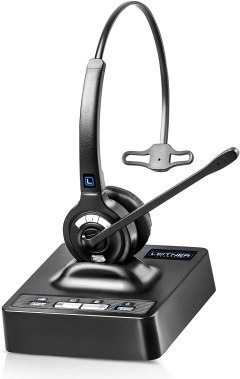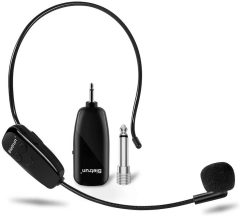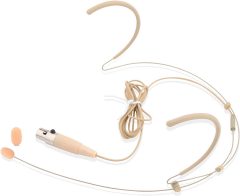BestReviews is reader-supported and may earn an affiliate commission. Details

Noise-canceling technology, long range, and good battery life make this monophonic option an appealing choice.
Noise-cancelation technology diminishes background noise so listeners can hear you clearly. Can travel as far as 350 feet from charging base. USB and phone jack can connect to 2 different devices at once. Lasts 8 hours of talk time on one charge.
Monophonic with only 1 earcup. Controls, including mute, are on the base, not the headset.

This wireless headset mic boasts a UHF connection even from far away.
Includes UHF transmitter that plugs into most audio sources with standard audio miniplug jack. Maintains connection up to 160 feet when unobstructed. High-sensitivity condenser. Headset and transmitter charge via USB.
Not designed for compatibility with smartphones and computers.

A sturdy, quality build and high-performance components make this a great choice for professionals.
Cardioid unidirectional mic delivers crisp, accurate audio. Flexible gooseneck for a comfortable fit in either behind-ear or headband form factors. Permanently-charged electret condenser. Windscreen built-in to soften plosives.
Headset only needs to be plugged into compatible Shure bodypack to function.

Light and almost invisible, this wireless headset mic is great for presenters and performers.
Notably thin and flexible behind-ears design offers wide freedom of movement, ideal for stage and performance uses. Omnidirectional mic with included foam wind screen. Electret condenser. Can work wired with 12 foot cord. 4-pin Mini XLR connector.
Needs to be plugged into compatible wireless body pack or transmitter.

High-grade wireless microphone system for professionals who don't mind paying the price.
Durable product with a very strong signal, long battery life, and excellent sound quality. The system is built for professionals, is easy to use, and works right out of the box.
It's sturdy build isn't as aesthetically pleasing as some may like. Wearing it for extended periods may take some getting used to. May require a license for operation in some locations.

We recommend these products based on an intensive research process that's designed to cut through the noise and find the top products in this space. Guided by experts, we spend hours looking into the factors that matter, to bring you these selections.

Whether your office is in your bedroom or a high-rise building, a certain amount of work must be accomplished each day. If that work involves phone calls, teleconferences, or virtual meetings, phone time can bring your productivity to a grinding halt.
However, if you have a wireless headset microphone, you can continue to get things done even while you're on hold or waiting for that salesman in Singapore to realize what time zone the meeting was in. A wireless headset microphone is a device that allows you to be hands-free on a phone call. It features either a single or a double earpiece, so you can listen, and a microphone, so you can talk. Your hands will be free so you can follow up on emails, type reports, or step away from your desk to refill your water bottle.

Since the primary function of a wireless headset microphone is to serve as a communication device, two key components are of concern to the consumer: the headphone and the microphone.
Some wireless headset microphones are worn on one ear; others are worn over both ears. If you are in an environment with a good bit of background noise, a pair of over-ear headphones that block out ambient noise may be preferred. Whichever option you choose, you need to be able to clearly hear the person you are calling, so high-quality headphones are a must. This is especially true if you plan on listening to music when you are not on a call.
The best microphone for your wireless setup will be an adjustable boom mic that you can maneuver into position close enough to your mouth so you can be easily understood. Additionally, if you share your work environment with a number of other people, you will want a microphone that doesn't pick up extraneous noise. It is also important to get a high-quality microphone so each and every word comes across clearly.

The three other areas to focus on when purchasing a wireless headset microphone are comfort, connectivity, and battery life.
If your wireless headset microphone is uncomfortable, you won’t want to wear it all day at work. Worse, if it is too tight, you could get a headache, which could impair your productivity. Comfort isn’t a luxury option when it comes to wireless headset microphones, so seek out a lightweight model that is adjustable and padded in the areas where it makes contact with your head.
To minimize frustrations, not only should your wireless headset microphone be easy to connect to whatever device you are using (desk phone, computer, cell phone), but it should not require a complicated reconfiguring in the event of a dropped signal. Also, a wireless headset mic should have a decent range so you're not tethered to your desk all day long. A wireless headset microphone that can pair with two different devices is a plus because it will allow you to swap between devices as needed. This would come in handy if you like listening to music when you are not on a call, for instance, or if you need to switch from using your desk phone to using your cell phone.
If you are so busy that you do not have time to charge your wireless headset while you are at work, you will need to look for a model that can last the entire work day. Otherwise, after five or six hours, your productivity may grind to a halt.

If you're looking for a low-end model, be careful about accidentally purchasing a corded headset at the low-end of the market. You start to get adequate wireless headset microphones in the $40 to $100 range. The best models at this price point are lightweight and feature noise-canceling mic technology, but they usually offer less control than pricier models.
If you need exceptional, reliable equipment that isn't in the highest price tier, expect to pay $100 to $200. In this price bracket, you will get more than enough range for typical office use, built-in call control, and exceptional audio with a noise-canceling microphone.
Expensive
Moving beyond $200, you get into the high-end of wireless headset microphones. These reliable models are manufactured by name brand companies and feature greater-operating-distance headsets that work on computers as well as desk phones, hot-swappable batteries, and other options that vary by model and manufacturer.


A. That depends on the features of your model and any accessories you may have, such as an electronic hook switch or automatic handset lifter to answer desk phone calls remotely. Essentially, you can listen and talk hands-free on a wireless headset microphone. Hopefully, you will choose a model that allows you to adjust the volume and mute audio, as well. Depending on the model, you can also accept and end calls on the headset. Additionally, you may be able to switch between speaking on your headset and speaking on the connected handset (if you are using a desk phone).
A. A wireless headset microphone does not allow you to perform any of the tasks that you need to do at your computer or your desk phone. You cannot initiate a three-way call by patching someone in, you cannot send a call to another extension, and you cannot send a call to voicemail. You also cannot place a caller on hold to answer another call. A wireless headset microphone is simply a convenient device that allows you to move about the office so you can accomplish other tasks while you are on the phone.
Get emails you’ll love.
Learn about the products you’re wondering if you should buy and get advice on using your latest purchases.
